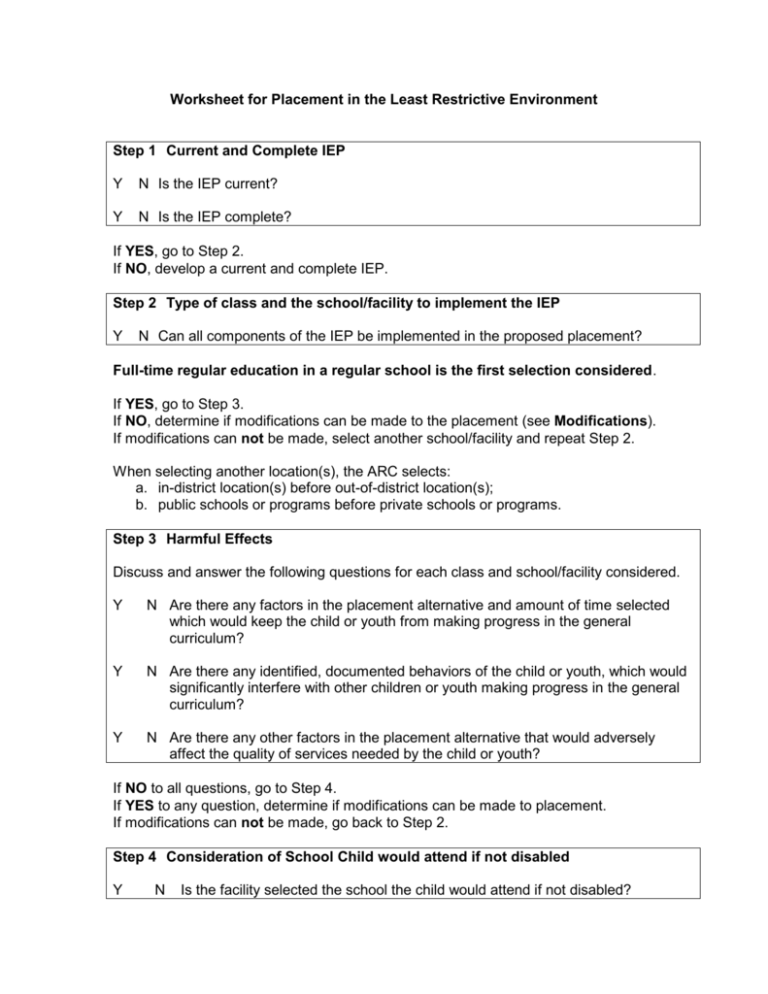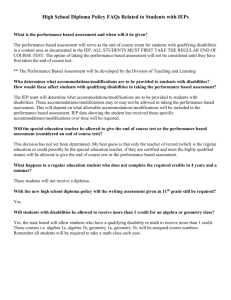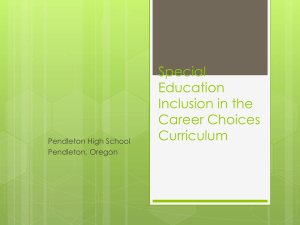LRE Worksheet - KEDC Special Education Cooperative
advertisement

Worksheet for Placement in the Least Restrictive Environment Step 1 Current and Complete IEP Y N Is the IEP current? Y N Is the IEP complete? If YES, go to Step 2. If NO, develop a current and complete IEP. Step 2 Type of class and the school/facility to implement the IEP Y N Can all components of the IEP be implemented in the proposed placement? Full-time regular education in a regular school is the first selection considered. If YES, go to Step 3. If NO, determine if modifications can be made to the placement (see Modifications). If modifications can not be made, select another school/facility and repeat Step 2. When selecting another location(s), the ARC selects: a. in-district location(s) before out-of-district location(s); b. public schools or programs before private schools or programs. Step 3 Harmful Effects Discuss and answer the following questions for each class and school/facility considered. Y N Are there any factors in the placement alternative and amount of time selected which would keep the child or youth from making progress in the general curriculum? Y N Are there any identified, documented behaviors of the child or youth, which would significantly interfere with other children or youth making progress in the general curriculum? Y N Are there any other factors in the placement alternative that would adversely affect the quality of services needed by the child or youth? If NO to all questions, go to Step 4. If YES to any question, determine if modifications can be made to placement. If modifications can not be made, go back to Step 2. Step 4 Consideration of School Child would attend if not disabled Y N Is the facility selected the school the child would attend if not disabled? If YES, go to Step 5. If NO, determine if modifications can be made to the child’s school. If modifications can not be made, document the ARC decision, and go to Step 5. Step 5 Participation with children and youth who are not disabled When a specific location has been identified, discuss and answer the following questions to determine if participation with children and youth who are not disabled is to the maximum extent appropriate: Y N Is it chronologically age-appropriate? Y N Does it provide an opportunity for interaction with children and youth who are not disabled? Y N Is the location on a regular school campus? Y N Are typical activities planned for personal and social interaction of children and youth who have disabilities with similar aged children and youth who do not have disabilities (e.g., meals, recess, clubs, etc.)? Y N Do the children and youth with disabilities use school resources simultaneously with similar aged children and youth who do not have disabilities? If YES to all questions, the student is participating with non-disabled peers to the maximum extent appropriate. If NO to any questions, determine if modifications can be made to the placement. If modifications can not be made, select another school/facility and repeat Step 2. Modifications may include: A. changing the physical environment (e.g., preferential seating, special lighting); B. using supplementary aids and services (e.g., counseling, physical or occupational therapy, large print books); C. reorganizing staff patterns (e.g., adding an instructional aide, changing teacher assignments); D. implementing different modes of instruction (e.g., whole language approach, cooperative learning, modeling); E. making adaptations to the curricula (e.g., learning strategies, social skills); or F. training personnel (e.g., special instruction techniques, behavior management techniques, etc.).




